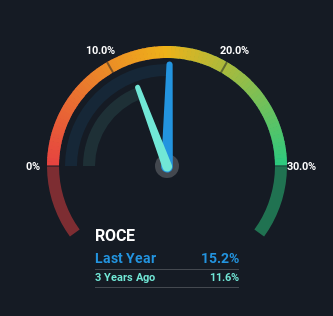- Japan
- /
- Metals and Mining
- /
- TSE:5707
Investors Will Want Toho Zinc's (TSE:5707) Growth In ROCE To Persist
What are the early trends we should look for to identify a stock that could multiply in value over the long term? Typically, we'll want to notice a trend of growing return on capital employed (ROCE) and alongside that, an expanding base of capital employed. Ultimately, this demonstrates that it's a business that is reinvesting profits at increasing rates of return. Speaking of which, we noticed some great changes in Toho Zinc's (TSE:5707) returns on capital, so let's have a look.
What Is Return On Capital Employed (ROCE)?
For those who don't know, ROCE is a measure of a company's yearly pre-tax profit (its return), relative to the capital employed in the business. The formula for this calculation on Toho Zinc is:
Return on Capital Employed = Earnings Before Interest and Tax (EBIT) ÷ (Total Assets - Current Liabilities)
0.15 = JP¥4.6b ÷ (JP¥114b - JP¥83b) (Based on the trailing twelve months to June 2024).
So, Toho Zinc has an ROCE of 15%. On its own, that's a standard return, however it's much better than the 6.4% generated by the Metals and Mining industry.
See our latest analysis for Toho Zinc

In the above chart we have measured Toho Zinc's prior ROCE against its prior performance, but the future is arguably more important. If you'd like to see what analysts are forecasting going forward, you should check out our free analyst report for Toho Zinc .
So How Is Toho Zinc's ROCE Trending?
We're delighted to see that Toho Zinc is reaping rewards from its investments and has now broken into profitability. The company was generating losses five years ago, but now it's turned around, earning 15% which is no doubt a relief for some early shareholders. At first glance, it seems the business is getting more proficient at generating returns, because over the same period, the amount of capital employed has reduced by 60%. The reduction could indicate that the company is selling some assets, and considering returns are up, they appear to be selling the right ones.
For the record though, there was a noticeable increase in the company's current liabilities over the period, so we would attribute some of the ROCE growth to that. Effectively this means that suppliers or short-term creditors are now funding 73% of the business, which is more than it was five years ago. Given it's pretty high ratio, we'd remind investors that having current liabilities at those levels can bring about some risks in certain businesses.
The Bottom Line
In a nutshell, we're pleased to see that Toho Zinc has been able to generate higher returns from less capital. Astute investors may have an opportunity here because the stock has declined 39% in the last five years. That being the case, research into the company's current valuation metrics and future prospects seems fitting.
Toho Zinc does have some risks though, and we've spotted 1 warning sign for Toho Zinc that you might be interested in.
If you want to search for solid companies with great earnings, check out this free list of companies with good balance sheets and impressive returns on equity.
Valuation is complex, but we're here to simplify it.
Discover if Toho Zinc might be undervalued or overvalued with our detailed analysis, featuring fair value estimates, potential risks, dividends, insider trades, and its financial condition.
Access Free AnalysisHave feedback on this article? Concerned about the content? Get in touch with us directly. Alternatively, email editorial-team (at) simplywallst.com.
This article by Simply Wall St is general in nature. We provide commentary based on historical data and analyst forecasts only using an unbiased methodology and our articles are not intended to be financial advice. It does not constitute a recommendation to buy or sell any stock, and does not take account of your objectives, or your financial situation. We aim to bring you long-term focused analysis driven by fundamental data. Note that our analysis may not factor in the latest price-sensitive company announcements or qualitative material. Simply Wall St has no position in any stocks mentioned.
About TSE:5707
Toho Zinc
Operates in the smelting and refining, mineral resources, electronic components, advanced materials, and environment and recycling businesses in Japan.
Reasonable growth potential and fair value.
Market Insights
Community Narratives


Recently Updated Narratives

TAV Havalimanlari Holding will fly high with 25.68% revenue growth


Fiducian: Compliance Clouds or Value Opportunity?


Q3 Outlook modestly optimistic
Popular Narratives


MicroVision will explode future revenue by 380.37% with a vision towards success


The company that turned a verb into a global necessity and basically runs the modern internet, digital ads, smartphones, maps, and AI.



